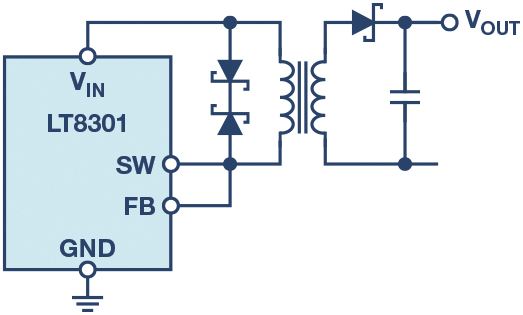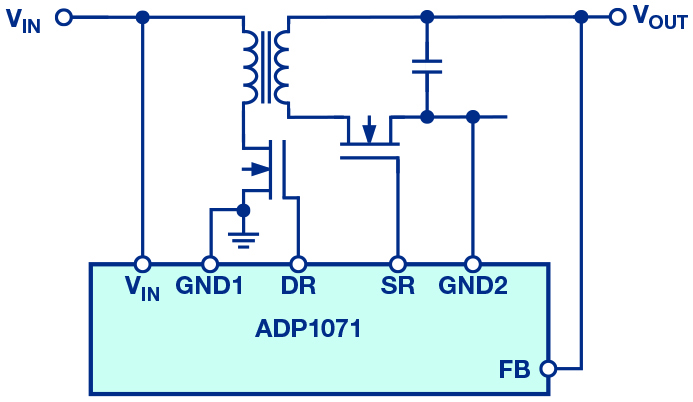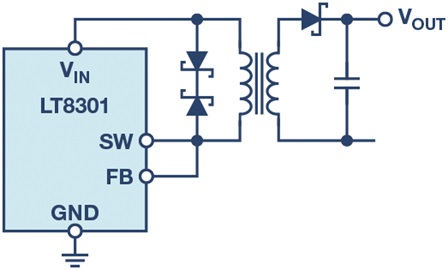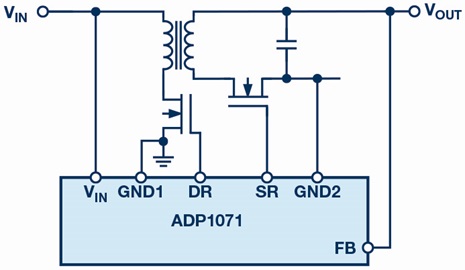Flyback Converters Without Optocouplers: Existing Options
Flyback converters are often used in applications in which galvanic isolation of a supply voltage is needed and the power to be transmitted is relatively low. Flyback converters are typically used up to about 60 W of output power.
With galvanically isolated power supplies, you have to decide which side of the galvanic isolation the controller, that is, the control integrated circuit, is going to be on. If it is located on the secondary side, control of the primary-side power switches must be provided through the galvanic isolation.
In both architectures, the controller on the primary side or the controller on the secondary side, paths for transferring a signal across the galvanic isolation are needed. Optocouplers, or opto-isolators, are frequently used for this. However, they have some unfavorable characteristics. They are usually only specified to a temperature of 85°C. Their current transfer ratio (CTR) changes over time, which means that their transfer behavior changes during the lifetime of a circuit. Also, additional components are required to control the optocouplers. The feedback loop of an isolated power supply is usually very slow if optocouplers are used. Elegant solutions to this problem have been developed in recent years. The first solution is a flyback controller, which does not measure the output voltage directly. Through investigation of the voltage across the primary-side transformer winding, sufficiently accurate conclusions about the actual output voltage can be made. The precision of this regulation depends on the application’s usual conditions, including input and output voltages, load changes, and line changes.
However, for numerous applications, a regulation accuracy of ±10% to ±15% is good enough. Figure 1 shows the LT8301. Thanks to the integrated power switch, the IC in an SOT23 housing requires very few external components. The isolation breakdown voltage of the circuit depends only on the transformer used. This allows for great flexibility, especially if very high isolation voltages are required.

Figure 1. The LT8301 flyback regulator without an isolated feedback path.
However, for applications requiring higher output voltage control accuracy, another interesting solution has just recently become available. With the ADP1071, Analog Devices has introduced a flyback controller that contains a completely integrated feedback path, with iCoupler® technology, to the market.
Figure 2 shows the circuit with a very small number of required passive components. The ADP1071 contains a primary-side controller, active secondary-side rectification for increased conversion efficiency, and the completely integrated feedback path for very fast feedback loops. Through this, the output voltage regulation is very accurate and, above all, very fast, even with large load transients. Operation is permitted up to a silicon temperature of 125°C.

Figure 2. The ADP1071 flyback controller with an integrated feedback path for very accurate regulation.
Here the maximum isolation voltage depends on the transformer selected as well as the isolation technology in the switching regulator IC. The chip has a maximum isolation voltage of 5 kV. Classification according to VDE V 0884-10 for reinforced insulation has been applied for.
Interesting solutions are available for developing galvanically isolated power supplies. Depending on the application case, a solution without a feedback path or one with a completely integrated feedback path may be suitable. Because the 85°C limitation of the optocoupler is done away with, compact power supplies with very high power densities can be designed.
About the Authors
Related to this Article
Products
42VIN Micropower No-Opto Isolated Flyback Converter with 65V/1.2A Switch
Isolated Synchronous Flyback Controller with Integrated iCoupler
Isolated Synchronous Flyback Controller with Integrated iCoupler
Product Categories
{{modalTitle}}
{{modalDescription}}
{{dropdownTitle}}
- {{defaultSelectedText}} {{#each projectNames}}
- {{name}} {{/each}} {{#if newProjectText}}
-
{{newProjectText}}
{{/if}}
{{newProjectTitle}}
{{projectNameErrorText}}





















